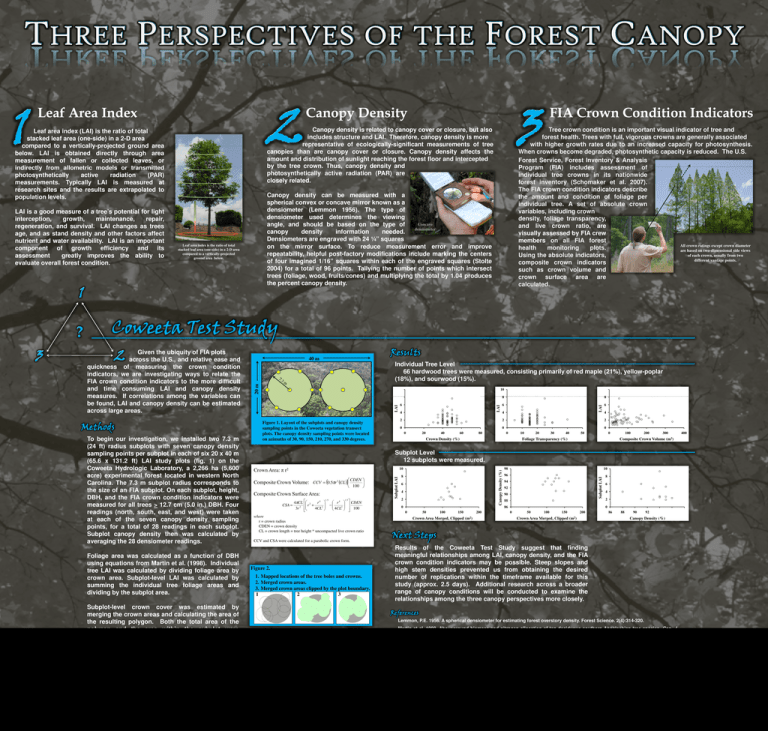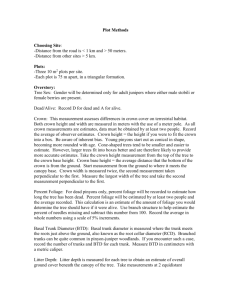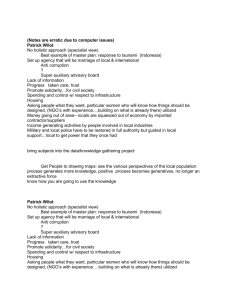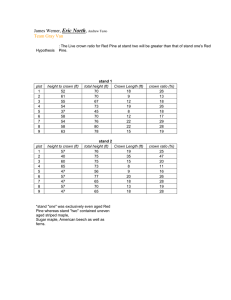T P F C
advertisement

THREE PERSPECTIVES OF THE FOREST CANOPY Leaf Area Index Canopy Density Canopy density is related to canopy cover or closure, but also includes structure and LAI. Therefore, canopy density is more representative of ecologically-significant measurements of tree canopies than are canopy cover or closure. Canopy density affects the amount and distribution of sunlight reaching the forest floor and intercepted by the tree crown. Thus, canopy density and photosynthetically active radiation (PAR) are closely related. Leaf area index (LAI) is the ratio of total stacked leaf area (one-side) in a 2-D area compared to a vertically-projected ground area below. LAI is obtained directly through area measurement of fallen or collected leaves, or indirectly from allometric models or transmitted photosynthetically active radiation (PAR) measurements. Typically LAI is measured at research sites and the results are extrapolated to population levels. LAI is a good measure of a tree’s potential for light interception, growth, maintenance, repair, regeneration, and survival. LAI changes as trees age, and as stand density and other factors affect nutrient and water availability. LAI is an important component of growth efficiency and its assessment greatly improves the ability to evaluate overall forest condition. FIA Crown Condition Indicators Tree crown condition is an important visual indicator of tree and forest health. Trees with full, vigorous crowns are generally associated with higher growth rates due to an increased capacity for photosynthesis. When crowns become degraded, photosynthetic capacity is reduced. The U.S. Forest Service, Forest Inventory & Analysis Program (FIA) includes assessment of individual tree crowns in its nationwide forest inventory (Schomaker et al. 2007). The FIA crown condition indicators describe the amount and condition of foliage per individual tree. A set of absolute crown variables, including crown density, foliage transparency, and live crown ratio, are visually assessed by FIA crew members on all FIA forest All crown ratings except crown diameter health monitoring plots. are based on two-dimensional side views of each crown, usually from two Using the absolute indicators, different vantage points. composite crown indicators such as crown volume and crown surface area are calculated. Canopy density can be measured with a spherical convex or concave mirror known as a densiometer (Lemmon 1956). The type of densiometer used determines the viewing Concave angle, and should be based on the type of densiometer canopy density information needed. Densiometers are engraved with 24 ¼” squares on the mirror surface. To reduce measurement error and improve repeatability, helpful post-factory modifications include marking the centers of four imagined 1/16” squares within each of the engraved squares (Stolte 2004) for a total of 96 points. Tallying the number of points which intersect trees (foliage, wood, fruits/cones) and multiplying the total by 1.04 produces the percent canopy density. Leaf area index is the ratio of total stacked leaf area (one-side) in a 2-D area compared to a vertically-projected ground area below. Coweeta Test Study Foliage area was calculated as a function of DBH using equations from Martin et al. (1998). Individual tree LAI was calculated by dividing foliage area by crown area. Subplot-level LAI was calculated by summing the individual tree foliage areas and dividing by the subplot area. Subplot-level crown cover was estimated by merging the crown areas and calculating the area of the resulting polygon. Both the total area of the polygon and the area within the subplot were calculated (fig. 2). Individual Tree Level 66 hardwood trees were measured, consisting primarily of red maple (21%), yellow-poplar (18%), and sourwood (15%). Figure 1. Layout of the subplots and canopy density sampling points in the Coweeta vegetation transect plots. The canopy density sampling points were located on azimuths of 30, 90, 150, 210, 270, and 330 degrees. 4 8 8 6 6 LAI 6 LAI LAI 10 4 4 2 2 2 0 0 0 0 20 40 60 80 0 10 Crown Density (%) 20 30 40 50 0 100 200 300 Composite Crown Volume (m3) Foliage Transparency (%) Subplot Level 12 subplots were measured. CDEN Composite Crown Volume: CCV = 0.5πr 2 (CL ) 100 ( ) Composite Crown Surface Area: 1.5 1.5 r 4 CDEN 4πCL 2 r4 − r + CSA = 2 3r 2 4CL2 4 CL 100 where r = crown radius CDEN = crown density CL = crown length = tree height * uncompacted live crown ratio CCV and CSA were calculated for a parabolic crown form. Figure 2. 1. Mapped locations of the tree boles and crowns. 2. Merged crown areas. 3. Merged crown areas clipped by the plot boundary. 1 2 3 8 6 4 2 0 0 50 100 150 Crown Area Merged, Clipped (m2) 200 98 10 96 8 Subplot LAI 10 Crown Area: π r2 Canopy Density (%) To begin our investigation, we installed two 7.3 m (24 ft) radius subplots with seven canopy density sampling points per subplot in each of six 20 x 40 m (65.6 x 131.2 ft) LAI study plots (fig. 1) on the Coweeta Hydrologic Laboratory, a 2,266 ha (5,600 acre) experimental forest located in western North Carolina. The 7.3 m subplot radius corresponds to the size of an FIA subplot. On each subplot, height, DBH, and the FIA crown condition indicators were measured for all trees > 12.7 cm (5.0 in.) DBH. Four readings (north, south, east, and west) were taken at each of the seven canopy density sampling points, for a total of 28 readings in each subplot. Subplot canopy density then was calculated by averaging the 28 densiometer readings. 40 m Subplot LAI Methods Results 20 m Given the ubiquity of FIA plots across the U.S., and relative ease and quickness of measuring the crown condition indicators, we are investigating ways to relate the FIA crown condition indicators to the more difficult and time consuming LAI and canopy density measures. If correlations among the variables can be found, LAI and canopy density can be estimated across large areas. 94 92 90 6 4 88 2 86 0 0 50 100 150 200 Crown Area Merged, Clipped (m2) 86 88 90 92 Canopy Density (%) Next Steps Results of the Coweeta Test Study suggest that finding meaningful relationships among LAI, canopy density, and the FIA crown condition indicators may be possible. Steep slopes and high stem densities prevented us from obtaining the desired number of replications within the timeframe available for this study (approx. 2.5 days). Additional research across a broader range of canopy conditions will be conducted to examine the relationships among the three canopy perspectives more closely. References Lemmon, P.E. 1956. A spherical densiometer for estimating forest overstory density. Forest Science. 2(4):314-320. Martin et al. 1998. Aboveground biomass and nitrogen allocation of ten deciduous southern Appalachian tree species. Can. J. For. Res. 28:1648-1659. Schomaker et al. 2007. Crown Condition Classification: A guide to data collection and analysis. Gen. Tech. Rep. SRS-102. USDA For. Serv. Southern Research Station. 78 p. Stolte, K.W. 2004. Measuring Tree Canopy Closure on FHM & FIA Plots with a Modified Convex Densiometer. Poster presented at the Chesapeake Bay Program’s Scientific and Technical Advisory Committee (STAC) and Forestry Workgroup’s Workshop on Urban Tree Canopy, May 24, 2004. Annapolis, MD. (Poster/Abstract) KaDonna Randolph, U.S. Forest Service, Forest Inventory & Analysis, Knoxville, TN Ken Stolte, U.S. Forest Service, Forest Health Monitoring, Research Triangle Park, NC 400





